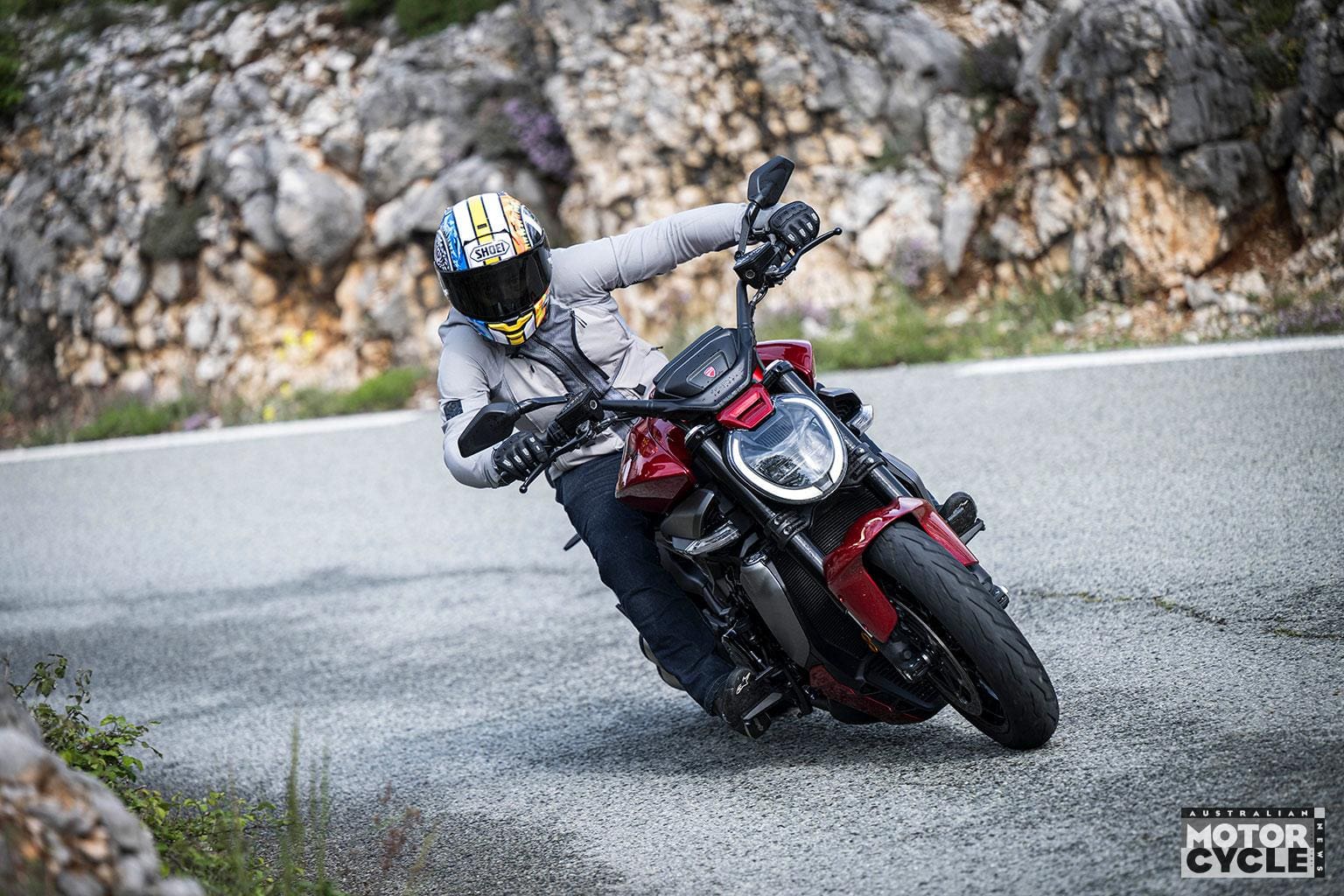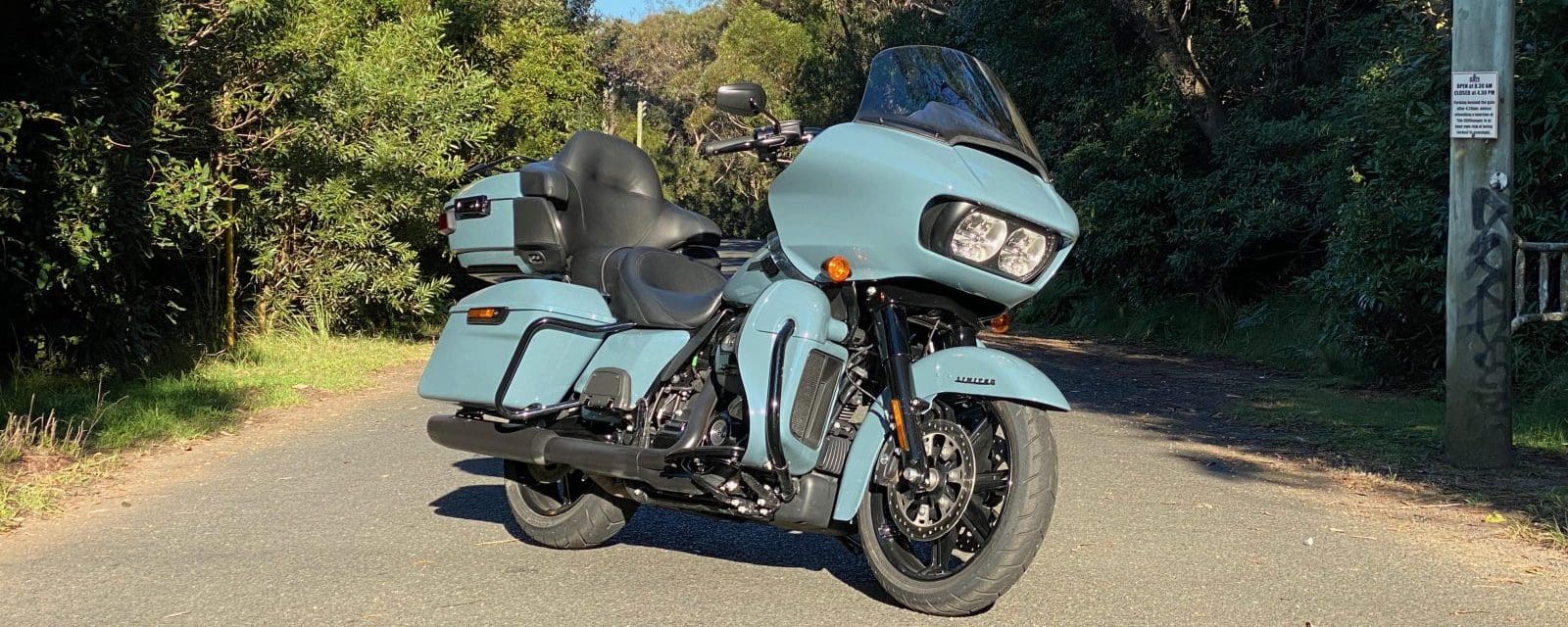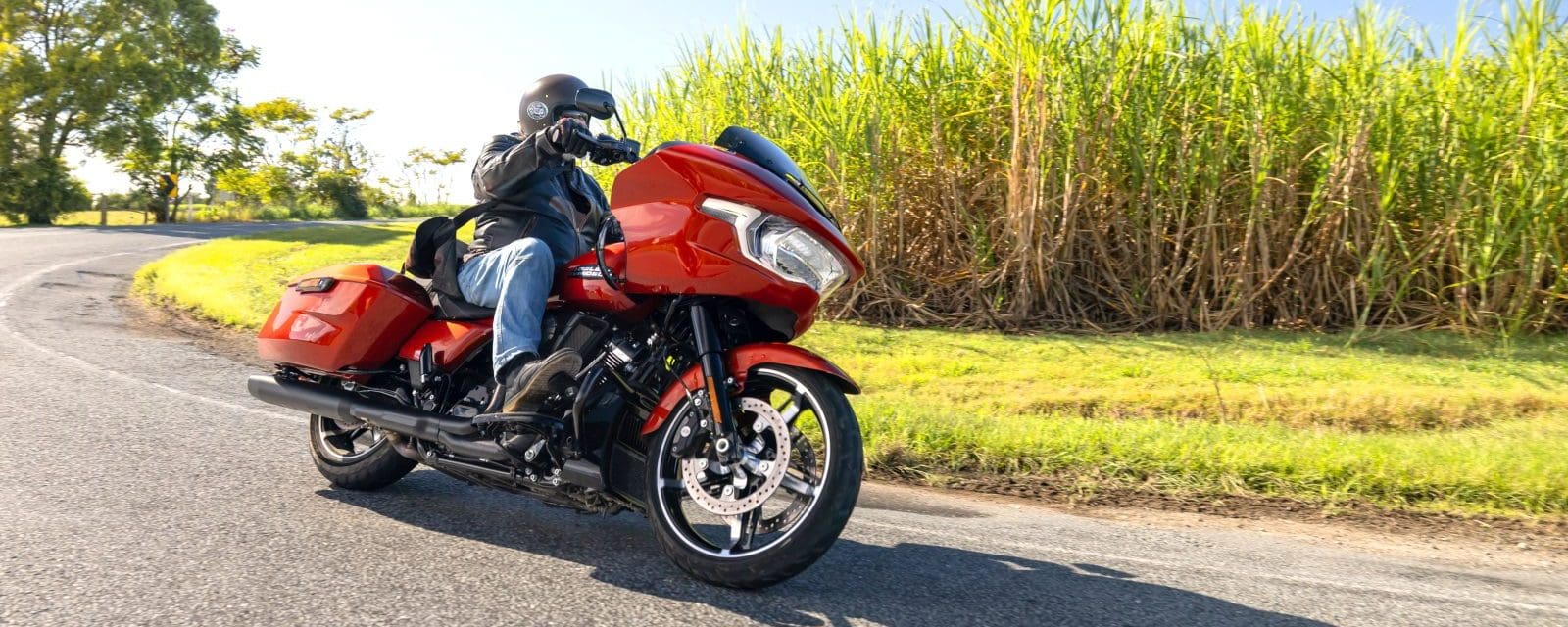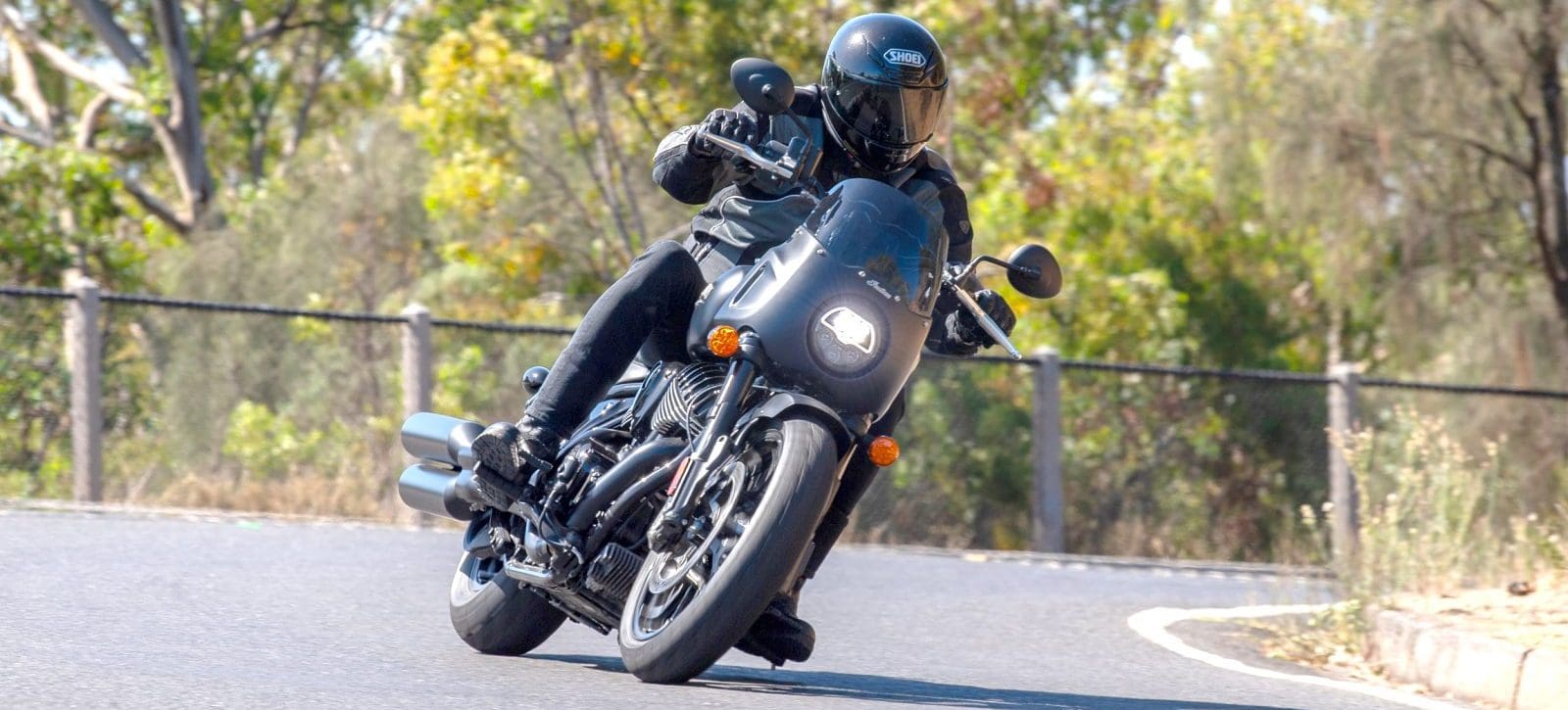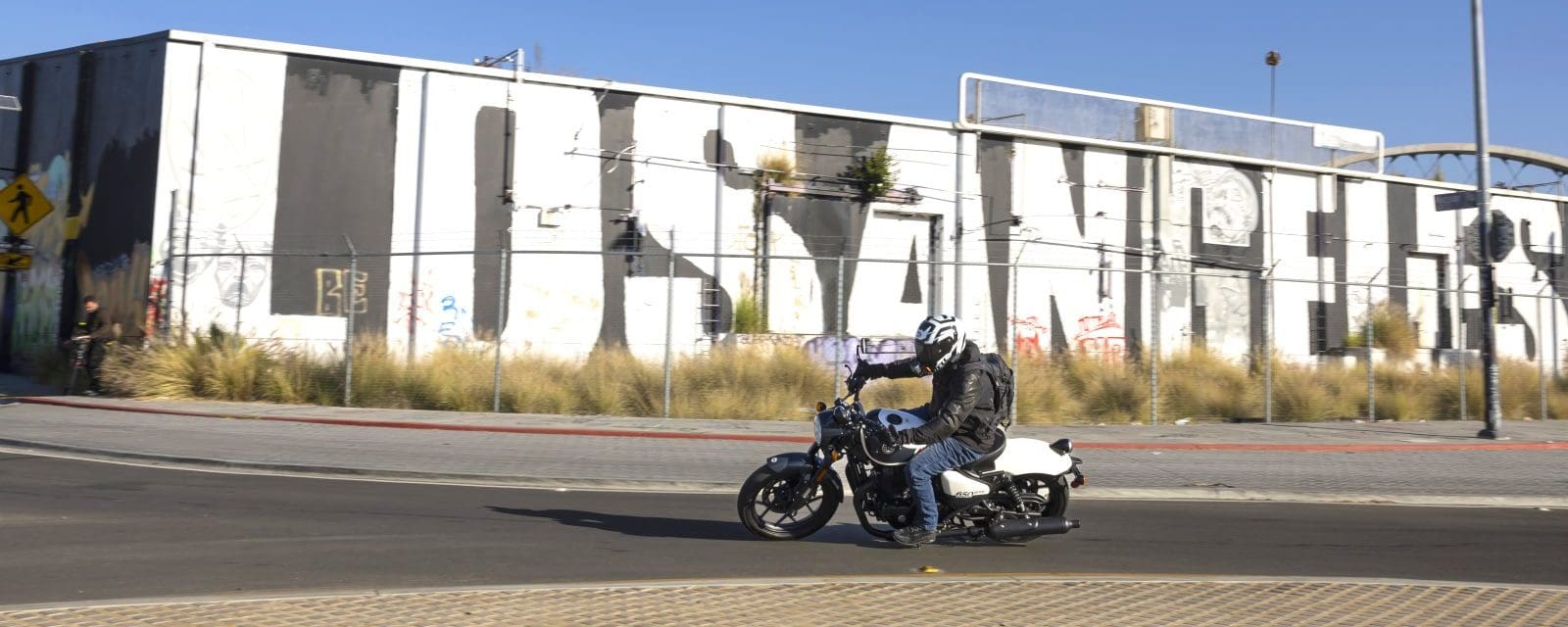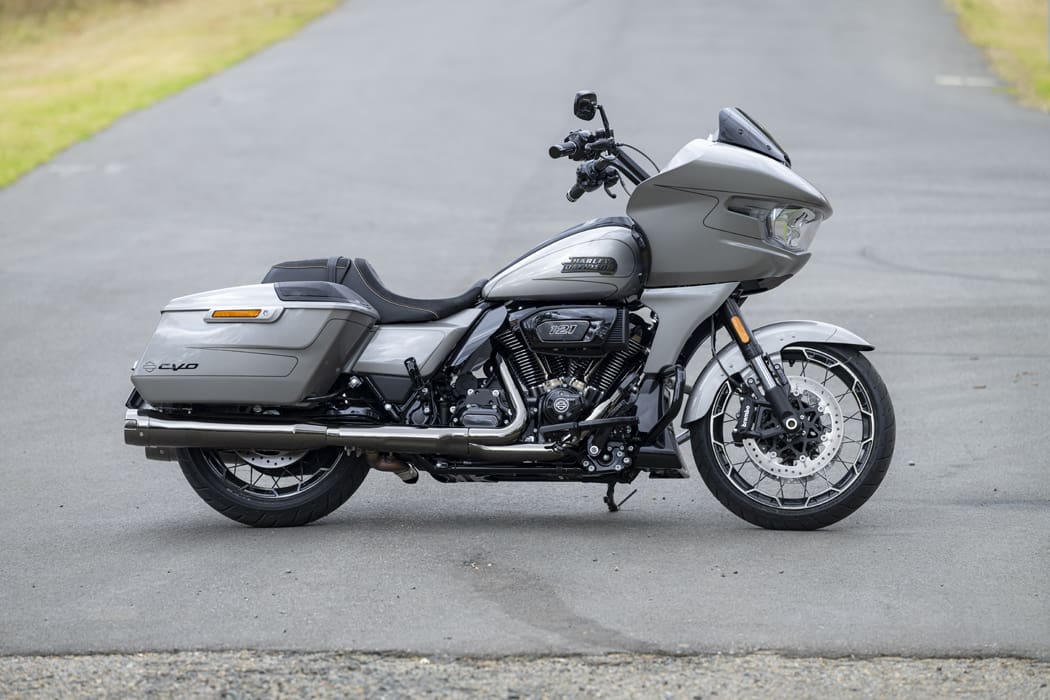Since stunning the motorcycling world with a record-breaking 2300cc engine back in 2004, the Triumph Rocket 3 has been the embodiment of motorcycling brawn, with more testosterone than a Mr Olympia line-up. In this era of political correctness and tightening emissions regulations it wouldn’t be a surprise to see the Rocket 3’s giant donk consigned to the history books but, to mark 20 years of sales success, Triumph has doubled down on its iconic power cruiser concept with the introduction of the wild new Rocket 3 Storm.
Somewhat confusingly the Storm is not a variation from the base model – all 2024 Triumph Rocket 3s are Storms and there are two versions available. The $39,890 (ride away) Storm GT features a more relaxed, cruiser-based riding position with forward-mounted foot controls, higher ’bar, pillion backrest and a lower, more padded seat. The less-expensive $38,890 Storm R variant is the hard-edged muscle-roadster with lower ’bar, mid-mounted ’pegs and an overall more agro riding position. Apart from that, the R and GT are mechanically identical, though the GT gets hand-grip warmers as standard equipment.


The sheer scale of the Rocket 3 is striking, from its immense, longitudinally-slung, straight-triple powerplant, to the huge 240-section rear Avon tyre, to the 300mm rear brake rotor, and massive single-sided swingarm, which incorporates the drive shaft. This level of power and torque requires big drivetrain engineering, and the Storm exudes sturdiness and strength like an Abrams tank.
That’s not to say it’s ungainly or rudely crafted though. The fit and finish are top notch and there’s exacting attention to detail everywhere you look, such as the pillion ’pegs that fold away invisibly into the bodywork when not in use, sharp LED lighting and the circular digital TFT dash arrangement that’s both classy and clear.
No motorcycle of this calibre would be complete without a comprehensive suite of electronics and there are plenty of rider aids to keep all that power in check.
Four riding modes are available – Rain, Road, Sport and Rider – which work with the digital throttle and a six-axis IMU to offer progressively more liberal traction control and throttle map settings. Rider mode can be fully customised for personal preference.
It’s easy enough to change between modes on the fly operating the dainty joystick with your left thumb, with the caveat that the throttle must be closed for safety reasons.
It isn’t the most intuitive infotainment interface I’ve sampled, but scrolling though the menus is relatively fuss free once you’re familiar with it. There’s also hill hold, cruise control and a keyless ignition, while Bluetooth connectivity for features such as music control and turn-by-turn navigation is available via the optional connectivity module.
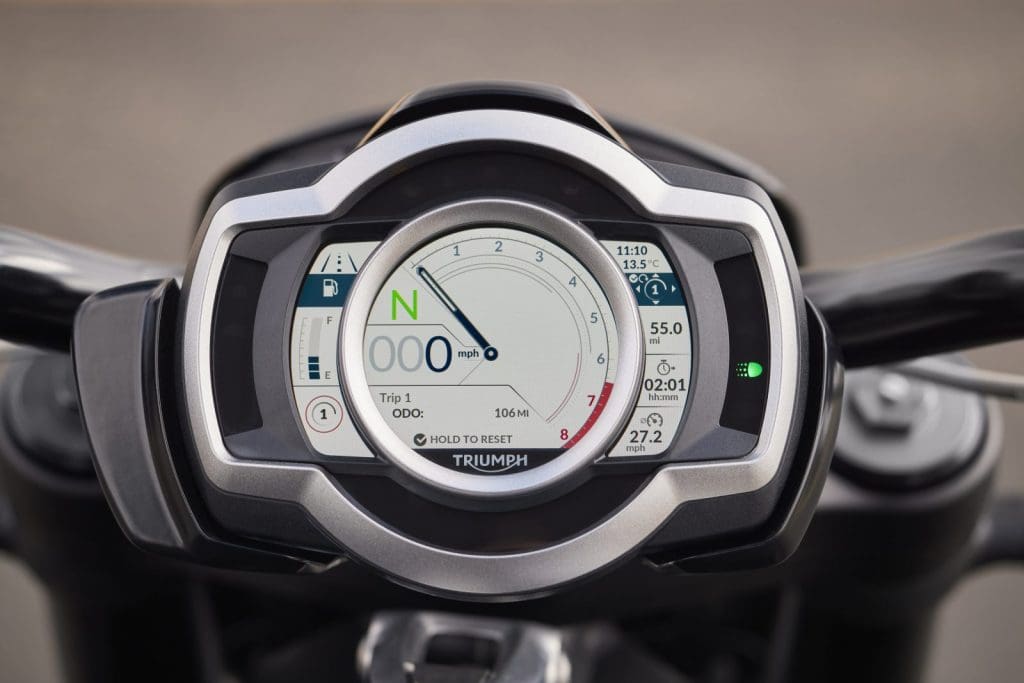
Not even a NASA engineer would dare suggest the Rocket 3 needed more thrust, but that didn’t stop the boffins at Triumph’s Hinkley HQ fettling the monstrous 2458cc triple-cylinder powerplant to produce an extra 11kW. In now spits out 134kW (179hp) at 7000rpm and a scarcely believable 225Nm of torque at just 4000rpm – that’s almost 80 percent more torque than the Ducati XDiavel – a bike most people would agree is pretty punchy.
The Storm also receives new cast-aluminium wheels, reducing weight to 317kg. But aside from that, all other changes are purely cosmetic, with dark, brooding colour schemes and blacked-out details to enhance its menacing stance.
Despite the Rocket 3’s steroidal appearance, it isn’t astronomically heavy for a cruiser in this category and handled impressively well when we threw it at some squiggly roads in the Adelaide Hills. Those enormous tyres and lengthy 1677mm wheelbase mean it doesn’t exactly fall into corners, but changes of direction don’t require a lot of muscle, and there’s a neutral feeling through the handlebar and competent mid-corner dynamics.
The Storm R’s more forward riding position makes it a more natural corner carver, but the GT was no slouch through the loopy sections either. The suspension offers plenty of support and feedback, and it turns so well I would probably make use of the 15mm-adjustable footpegs to give it some extra ground clearance. Slinging the hefty, hard-hitting Rocket 3 down a winding road feels bizarrely graceful, like dancing the foxtrot with George Foreman.
Through more rutted bends you eventually arrive at the limits of what the Showa fork and rear shock can iron out properly, but a machine of this size is not pretending to be a sportsbike. I found it more fun to adopt a slow in/fast out approach, where the Rocket’s planet-turning torque has the rear tyre madly scrambling for grip as the triple growls like Chewbacca and propels you down the road as if you’ve been fired from a bazooka.
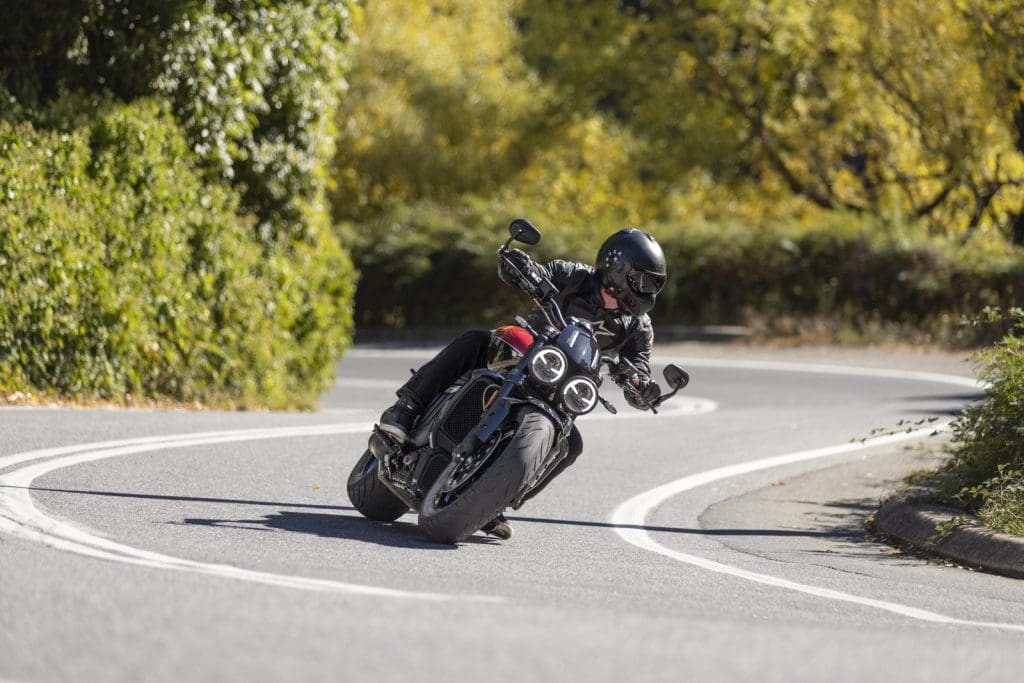
In Sport mode the traction control intervention was barely perceptible and allowed some slip, to the point where I could feel the rear Avon being smeared across the road with even moderately provocative throttle applications. The long, stable wheelbase makes it feel fun rather than butt-clenching, but getting the throttle wide open on a twisty road is still basically impossible.
While the Brembo brakes offer effective stopping power and feel, it pays to remember just how rapidly that huge powerplant converts fuel into kinetic energy.
While it handles better than any motorcycle this big ought to, the open road feels like more natural territory. Considering there are three sledgehammer-sized pistons firing away at speed between your legs the triple is very smooth, with just enough vibes to let you know you’re riding something very potent.
At highway speeds the engine ticks away at just over 2000rpm and overtaking is hilariously effortless in any gear, at any point in the rev range. It’s also ridiculously flexible, pulling easily from near idle revs in sixth gear. Even in Rain mode it felt like there was enough torque on tap to tow a B-double, and straight-to-jail speeds appear on the digital dash almost instantaneously if you slap the go-grip open. All that prodigious stomp makes gear changes pretty much redundant on the open road but when you do need to swap cogs the lever feel is light and precise, once again belying the Rocket’s thuggish demeanour.
On rural South Australia’s interminably straight stretches of bitumen the GT’s more laid-back riding posture allowed me to settle in for a comfortable cruise, although the low screen didn’t deflect much wind blast. The forward-mounted ’pegs are nicely positioned and, although my outstretched calf was resting slightly against the engine, the heat shields ensured nothing got roasted. My posterior was also well catered for by the lovely, plush seat, although I did find the suspension tune to be pretty firm over more poorly maintained country roads. Where the taut damping was a boon when dragging ’pegs through Adelaide’s scenic hills, for touring duties the Showa suspension transmits road undulations through to the ’bar and seat with unnecessary diligence. Dialling back the rebound and compression helped somewhat, but the Rocket still felt a bit heavily sprung for my 80kg ballast.
At the end of the day we arrived at the Shell V-Power Motorsport Park at Tailem Bend, where Triumph had booked a session on the new drag strip with instructions to not be overly concerned with tyre life.
It was slightly intimidating sitting at the starting beam on the Rocket 3, with the entire machine swaying slightly with the force of the crank rotation as the revs built.

The strip curator assured us that a recent event had laid down plenty of grippy rubber, but when the lights dropped and I let the clutch out the rear tyre spectacularly unglued itself from the tarmac. A fat, smoky strip of fried Avon was left behind as the Rocket arced sideways across the strip, the rear tyre squealing forlornly into second gear as it tried to contain the monumental grunt it was being force-fed. By the time it eventually regained some composure in third gear, it was clear that some adjustments in technique would be needed to make better use of the insane torque.
Over the next few runs I experimented with my clutch-release point and the Rocket began to hook up better, resulting in absolutely relentless acceleration, the force of the wind blast quishing my visor back into my face. The Storm R’s ride position allowed me to place my bodyweight over the tank to ensure the front tyre stayed down, although the chassis stability meant it was far more likely to barbecue the rear than loft the front.
For the last run I indulged in a preparatory burnout to get more temperature in the tyre, and that finally did the trick. The Rocket launched hard off the line, with just a whiff of wheelspin, before it dug in hard and blasted me down the chute like I’d been shot from a catapult.
The final pass resulted in an 11.3 second 400m elapsed time and a terminal speed of 205km/h – impressive for a motorcycle that’s as aerodynamic as a brick and weighs over 300kg. With some set-up adjustments and a bit more practice, a 10 second quarter-mile is surely feasible. The optional quickshifter might also help shave off a tenth or two.

When the smoke cleared and my heart rate returned to something approaching normal, I attempted to wrap my head around what it would be like to own the new Rocket 3, which in some ways occupies a motorcycling niche. In R spec it makes an extremely big, heavy, muscle-roadster, while in GT trim the suspension and screen aren’t ideal for touring, although of course it’ll churn out the kilometres no problem when required.
The claimed 6.6L/100km economy figure equates to a range of only around 260km from a full 18-litre tank and, at nearly 40 grand, I reckon tyre pressure monitoring, Bluetooth connectivity and a quickshifter should be standard fitment rather than optional extras.
But all that kind of misses the point, because the Rocket 3 Storm is playing in a league of one, with a behemoth engine that makes comparisons to other machines seem preposterous. Nobody ‘needs’ a motorcycle with 225Nm of torque, but that feeling of being shoved in the back by a maglev train whenever you flex your right wrist would never, ever stop being outrageously entertaining. If you like the idea of a refined muscle cruiser that corners fantastically but can also set its rear hoop on fire on the way to a 10-second quarter mile, then the Rocket 3 is for you.
The Rocket 3 Storm feels like a big, bold triple exclamation mark in the story of internal combustion motorcycles. In years to come it will surely be a revered icon.
ROCKET POWER
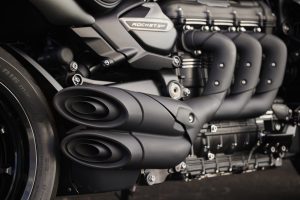
THE ROCKET 3 Storm’s 2458cc powerplant stands as the world’s largest mass-produced motorcycle engine.
A major upgrade in 2018 increased capacity by 152cc while simultaneously massively reducing engine weight, with an 18kg saving achieved through strategic enhancements to the crankcase assembly, adoption of a dry-sump lubrication system with an integral oil tank, and the introduction of new balancer shafts.
The innovative hydro-formed, three-header, exhaust system also optimises exhaust gas routing for enhanced sound and performance. Generating a peak power output of 134kW (179hp) at 7000rpm, the new Rocket 3 Storm straight triple is eight percent more powerful than the previous model. Torque output has also been increased by 4Nm, to a mind blowing 225Nm at 4000rpm.
PROS: This big brute plays in a league of its own with stupendously addictive and entertaining engine thrust.
CONS: Fuel range around 260km and, for the price, tyre pressure monitoring, Bluetooth and quickshifter should be standard.
WORDS: DAMIEN PELLETIER PHOTOS: DEAN WALTERS
THE COMPETITION
Ducati XDiavel
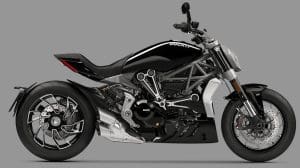
1262cc Testastetta V-twin
Power 112kW @ 9500rpm
Torque 126Nm @ 5000rpm
Kerb weight 247kg
$33,300 (ride away)
Harley-Davidson Fat Bob 114

1868cc air-cooled V-twin
Power 69kW @ 5020rpm
Torque 155Nm @ 3000rpm
Kerb weight 306kg
$33,750 (ride away)
Indian Chief Dark Horse
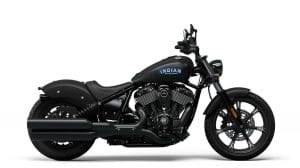
1890cc air-cooled V-twin
Power Not quoted
Torque 162Nm @ 2900rpm
Kerb weight 304kg
$28,995 (ride away)
SPECIFICATIONS – TRIUMPH ROCKET 3 STORM
ENGINE
Capacity 2458cc
Type In-line three-cylinder, DOHC, four-valves per cylinder
Bore & stroke 110.2 x 85.9mm
Compression ratio 10.8:1
Cooling Liquid-cooled
Fueling EFI
Transmission Six-speed
Clutch Wet, multiplate
Final drive Shaft
PERFORMANCE
Power 134kW (179hp) @ 7000 rpm (claimed)
Torque 225Nm @ 4000 rpm (claimed)
Top speed 225km/h (est)
Fuel consumption 6.6L/100km (claimed)
ELECTRONICS
Type Continental
Rider aids Cornering traction control, cornering ABS, four ride modes, hill hold control, cruise control, keyless ignition
Modes Rain, Road, Sport and Rider configurable
CHASSIS
Frame material Aluminium
Frame type Backbone
Rake 27.9°
Trail 134.9mm
Wheelbase 1677mm
SUSPENSION
Type Showa
Front: 47mm USD fork with compression and rebound adjustment, 120mm travel
Rear: Monoshock, fully adustable, 107mm travel
WHEELS & BRAKES
Wheels Cast aluminium
Front: 3.5 x 17 Rear: 7.5 x 16
Tyres Avon Cobra Chrome
Front: 150/80R17 V Rear: 240/50R16 V
BRAKES
Brembo
Front: Dual 320mm discs, radial four-piston Monobloc calipers
Rear: Single 300mm disc, dual-piston caliper
DIMENSIONS
Weight R: 319kg GT: 320kg
(kerb, claimed)
Seat height R: 773mm
GT: 750mm
Width 920mm
Height R: 1125mm GT: 1183mm
Length 2365mm
Ground clearance Not given
Fuel capacity 18L
SERVICING & WARRANTY
Servicing
First: 1000km
Minor: 16,000km
Major: 32,000km
Warranty: 24 month, unlimited km
BUSINESS END
Price R:$38,890 GT:$39,890 (ride away)
Colour options Carnival red/Sapphire black, Satin Pacific blue/Sapphire black or Granite/Sapphire black
CONTACT
triumphmotorcycles.com.au

